Thursday, February 3, 2011
Purchase the ebook by clicking the "Buy Now" button at the bottom of the page.
After completing the purchase you will be directed to a web page which will give you a link to the download site.
"A Practical Book of Instruction in the Art of Illustration. Presenting Numerous Reproductions of Original Drawings by America's most Famous Illustrators, Cartoonists and Comic Artists." Published in 1904.
107 pages of text and illustrations including the introductory pages. Most Illustrations are full page.
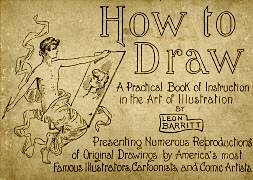
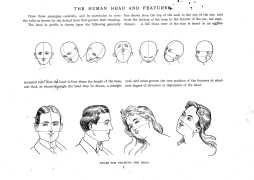
Leon Barritt, in his volume on "How to Draw; A Practical Book of Instruction in the Art of Illustration," (Harpers,) sets forth, in a simple and practical manner, the basic principles of illustration in pen and ink and pencil. He begins with a description of the reproduction of drawings, followed by a discussion of the materials ...
Read The January 14, 1905, New York Times, SATURDAY REVIEW BOOKS, review of How to Draw By Leon Barritt
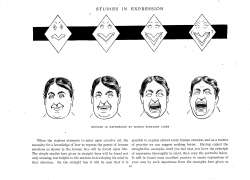
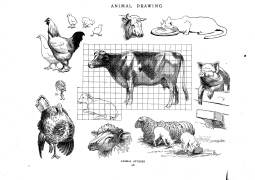

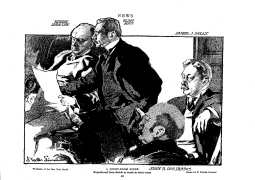


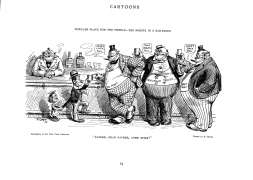
Contents
List of Artist Contributors Note to the Contributors Introduction Pen-and-Ink Drawing Material Primary Instruction First Lesson Line Work Studies Rules for Drawing the Head Rules for Drawing the Eye, Ear,and Mouth Rules for Drawing the Hands Rules for Drawing the Feet The Human Figure Measuring by the Eye Drawing from Life Measurements of the Human Figure Show Studies Drawing from Life - Children Drawing from Life - Drapery Studies in Expression Animal Drawing | Perspective Landscape Drawing Spatter Work Water Studies Comics Cartoons Wash Lamp-Black Drawing Distemper Drawing Drawing on Silver Prints Lettering How to make an Ellipse Tint Papers Scale for Reducing Drawings Sharpening Pencils News and Story Illustrations Foliage Study Examples of the Work of America's Most Famous Illustrators: News Fiction Cartoons Comics |
How to Draw
by Leon Barritt
$3.95
Wednesday, February 2, 2011
I've been asked several times by different members to post a tutorial on how I age-progress a person. So, here it is!
Men and women age a little bit differently but since I've only aged female celebrities thus far, I'll just focus on women for this tutorial. Ill be using the image of Katie Holmes that I did for a past W1K contest, as an example.
- Permalink No replies
When deciding to age-progress a celebritys face, I try to select a picture that is touched-up as little as possible.
I find that candid shots, or any shots that have not been taken in a studio, work best because the resulting harsh lighting reveals more of the skins details i.e. slight bags under the eyes and faint wrinkles. The appearance of such details makes it all that much easier to visualize how your subject will age. Visualizing what the end result will look like brings you one step closer to aging her face realistically.
In Katies case, we can see very faint horizontal lines on her forehead, fairly obvious lines under her eyes and lines bracketing her mouth.
- Permalink No replies
Reference material is key in my method of aging. Keeping Katies face in mind, I scoured the Web, looking for faces of old women who either resemble Katie and/or share the same facial expression. Here, Katie is smiling with her face positioned at a 3/4 angle so I tried to gather as many pictures of old women who are smiling in the same manner or close to that. I then opened up the picture of Katie in Photoshop and pasted the found images around her face on a separate layer, spread out to provide easy visual access.
Another kind of reference I like to use but is usually hard to find, is pictures of the subjects parents. I managed to find a couple of reference pictures of Katies mother online and they really helped me to decide whether or not to give Katie a double chin. Since her mom has quite a bit of mass under her chin, I decided I would apply that to Katie too.
- Permalink No replies
Now the fun begins! The first thing I like to do is to thin out the subjects eyebrows and eyelashes. The older people get, the thinner their hair gets - either because hair falls out and/or because it dries out as it greys.
So to achieve this, I like to use the Clone Stamp tool at 100% with a relatively small brush size depending on the size and resolution of the image. I sampled the surrounding skin to thin and reduce the number of hairs.
- Permalink No replies
Next, I like to add the basic sags to the skin. I do this in the Liquify mode. I tried to create sagging effects to the cheeks, jowls and the cliff just above the eyes by using the Push tool. For the eyes, I tried to be subtle; otherwise she may end up looking somewhat ghoulish.
From what Ive learned about the aging process, I know that while bones cease to grow, and in fact shrink, cartilage does continue to grow. As a result, the end of a nose may appear larger as a person grows older. So while I was still in the Liquify mode, I used the Push tool to extend the length of the nose slightly. Then I used the Bloat tool to also enlarge it slightly, being careful not lose the essential quality or character of the nose. Go too far and it may not look like Katie anymore.
- Permalink No replies

Based on her mothers pictures, I then added a fairly massive double chin. I initially used the Airbrush tool with some fairly broad strokes, sampling the colors that were already in the area of her neck. I then worked in the details with a finer brush size. Also, keep in mind that I was also using the other reference photos of older women to guide me.
- Permalink No replies
For me, the most important parts to get right are the eyes. They can make or break the project. Done wrong and the picture may no longer be identifiable as one of Katie Holmes anymore. I sought out the fine lines around the eyes and I tried to imagine how they would progress into wrinkles. I then extended them in length and width accordingly. Referencing the pictures of old women helped a lot with this step.
I used a combination of the Stamp tool and Brush tool. I wish I could explain my technique at this point in a more clinical manner but mostly I relied on my artistic instincts. I emphasized the wrinkles around the eyes by widening and deepening the lines slightly and increasing the contrast by darkening the recesses and lightening the edges. Also, I extended wrinkles to the cheekbone areas. I then applied the same technique to the wrinkles around the mouth and to the forehead.
- Permalink No replies
In this step, I work on the lips. As people grow older, the outline of the lips tends to recede. Using the Stamp tool, I sampled the skin surrounding the lips and thinned them out.
While I was at it, I also added a few vertical wrinkles above the lips to give her a bit of a "prune" effect. We just want a hint of that, so dont carve out deep lines; deep lines would only be necessary if she was puckering her lips.
- Permalink No replies

Here, on a separate layer, I faintly outlined or sketched, with a relatively thin brush size, areas that I may or may not add more lines and wrinkles to. Its easy to get carried away with the addition of wrinkles. So, I stopped, took a step back and assessed where to take to image. For me, it's essential and a great test to see what best works.
- Permalink No replies
Based on the previous step, I added wrinkles where I thought they were needed most. 
Overall, I found that the wrinkles and lines seemed a little flat in comparison to the rest of Katies features. They needed more definition so that they could pop out more. So, I highlighted the raised edges of the individual lines with the Brush tool and with a lighter skin tone.
- Permalink No replies
Facial hair becomes an issue with most women as they age. For some strange reason they lose it in the brow area and grow it back around the mouth area. I didnt want Katie to be the exception so with a very fine brush size and the Brush tool, I added hairs to her upper lip.
I tried to make it as subtle as possible. Hairs too thick or dark would draw the viewers attention straight to her mustache and I didnt want that. I also added more wrinkles to the area below the corners of her mouth.
- Permalink No replies

I decided that the neck was too smooth for a woman of 75 years of age. So I added finer wrinkles to that area. Also, I added more mass and weight to her jowls with the airbrush by increasing the value of the tones in those areas thus creating more contrast between surface planes.
- Permalink No replies
A key component to effective aging of a face is the addition of age spots.
So at this point, I sampled one of the darker skin tones on her face, and on a separate layer that was set to Multiply and 30% opacity, I brushed them in and tried to create irregular shapes (there IS no perfect age spot). You can add as many as you like; the amount varies from person to person. I decided to be conservative with Katie.
- Permalink No replies
I took a little break from it and came back to it later to possibly get a better perspective on it. When I looked at it, at this point, I decided that certain areas needed refining and added detail. This is the beauty of working with a high-resolution file; I can zoom in real close and deal with a wrinkle up-close and personal.
Unless their teeth were subjected to regular whitening, most peoples teeth yellow with age. Gums also recede, showing less gum and more bone. And so with that in mind, I sampled a yellowish-brown color and on a new layer that was set to Multiply and 30% opacity and painted that color to the teeth with the Brush tool. Her gums didnt show to begin with, so receding the gums here wasnt necessary.
- Permalink No replies

The finishing touch here is greying the hair. I began by creating a mask defining the area of the hair. I used the brush for this and tried my best to define as many loose strands of hair that I could.
With this mask as a selection, I then created a Hue/Saturation adjustment layer and reduced the saturation to 63.
I then created a new adjustment layer based on the same mask and adjusted the Brightness/Contrast to brightness +9 and contrast 36. As a result, I found that the darker areas were too pale and caused a loss of depth and so to adjust that, I then selected the mask and scratched out the darker areas with a 5px brush size at 50% opacity so that they could show through from the original image.
- Permalink No replies
The next step was to raise the hairline and thin out the hair. Hair loss is common with both sexes.
I sampled the area at the top of the forehead and extended the skin area above the original hairline.
- Permalink No replies
A lot of details of the hair were lost in the previous step so with a thin brush size at 80 percent opacity I drew in fine grey hairs, sparsely laid out.
Patiently, slowly, stroke by stroke I added more and more hairs until I was happy with the amount of grey I had added.
- Permalink No replies
Finally, I took a step back, refined a few wrinkles here and there ET VOILA!
I hope this tutorial was insightful. It may not be the most technically detailed tutorial but it gives you a good idea of the process I go through to get the job done. Hopefully, it will help you create your own trophy-winning images for future Fountain of Age contests!
- Permalink No replies
Labels
Popular Posts
-
by Tony Celeste In this article, you'll learn how to use Corel PHOTO-PAINT 12 with your digital camera. I'll go over the entire pr...
-
by Tony Celeste One of the most common challenges in Web design is creating content that maintains a consistent look and feel regardless ...
-
How to Draw Hands: 35 Tutorials, How-To’s, Step-by-Steps, Videos, Studies, Poses and Photo References 21 Comments | October 19, 2009 I’ve f...
-
By Steve Bain If the documents that you create with CorelDRAW Graphics Suite 12 don't match the material size to which you're pri...
-
Before You Code » Site Planning So you want to build a website, and you're eager to write some code. Not so fast! You'll need to do...
-
How to Draw Purchase the ebook by clicking the "Buy Now" button at the bottom of the page. After completing the purchase you wi...
-
By Steve Bain Whether you're a professional, a tourist or just a weekend photo hobbyist, there's nothing like taking a few pictures...
-
By Steve Bain As anyone new to printing from a graphics application can tell you, print errors can sometimes be a scary and costly experi...
-
Complete Course of Cartoon Drawing megaupload » Free Downloads RapidShare Megaupload Mediafire Torrents HotFile Uploading Easy-Share FileFac...
-
A Detailed Look at the 960 CSS Framework | Nettuts+
Blog Archive
-
▼
2011
(13)
-
▼
February
(10)
- FREE Cartoon Drawing Lessons
- Complete Course of Cartoon Drawing megaupload » Fr...
- How to Draw
- Drawing - drawing guide books Hotfile Rapidshare F...
- The Aging Process - Worth1000 Tutorials
- The Aging Process - Worth1000 Tutorials
- Hands for Drawing - Posemaniacs.com
- Hands for Drawing - Posemaniacs.com
- Free Vector Female Hand Silhouette Holding » Free ...
- How to Draw Hands: 35 Tutorials, How-To’s, Step-by...
-
▼
February
(10)




